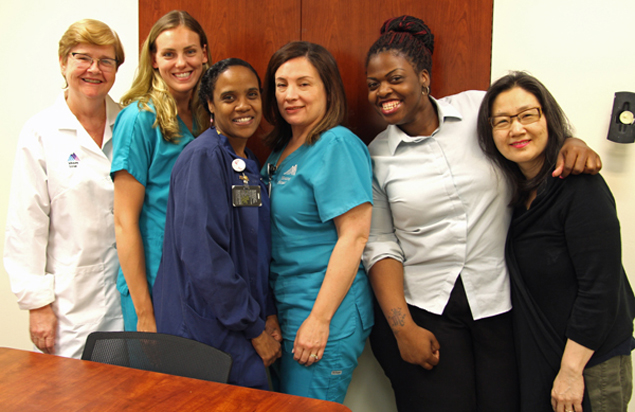When staff from the KP5 unit in Mount Sinai Hospital’s Women and Children Services Department gathered to be a part of a new process improvement project, the unit was known as a bit of an underdog, according to KP5 Manager Ann Clampet. “Our unit was having difficulty reaching Press Ganey scores,” says Clampet, the management facilitator for the project. “We understood that we needed to become a stronger team if we were going to meet our goals consistently.” The labor management team saw this as an opportunity: an ideal chance to improve both patients’ and staff members’ experiences and satisfaction levels.
The focus of the project was interdisciplinary team building using purposeful hourly rounding as a framework. Under the guidance of Regina Censullo, a consultant with the Labor Management Project, the team met weekly to review data and find tools to improve teamwork with a focus on patient-centered care in their unit. “This project was co-designed by 1199, NYSNA, Mount Sinai Hospital and the Labor Management Project with a strong partnership and support from all partners starting from inception,” says Censullo.
“We actually enjoyed spending time together and learning how we can improve the unit,” says KP5 Patient Care Associate and Labor Facilitator Sharon Cedeno. Christine Sullivan, who is also a nurse in KP5, agrees with Cedeno. “As a team, we really worked well together,” she says. “We were determined to make a difference.”
Team-building, peer-to-peer coaching and validation was taught to the KP5 staff. Team members provided the training, serving as coaches and facilitators. Training included staff-produced video clips in which some staff played the part of patients to demonstrate best practices in rounding on patients in challenging situations. It was a true interdisciplinary approach. Over the course of three weeks, 126 healthcare workers on three units were trained, including managers, patient care assistants, business associates, nurses, environmental service workers, support associates, dietary workers and lactation consultants.
The team and the staff who were trained then discussed what worked, what didn’t work, and what needed improvement. In addition, a validation app on their iPads allowed staff to receive feedback directly from one another, learning what they did well and what they could improve on. The team said it was a huge adjustment for staff to get validated by their peers, and it took some time to get used to no longer having a manager provide that validation. “It has been a culture change. We still have staff getting adjusted to this new process,” says KP5 Business Associate and Labor Facilitator Pamela Brooks.
Another major change is that all staff are now aware that they are responsible for improving the patient experience. In the past, staff from different areas might enter a patient’s room as many as five times within an hour to carry out different tasks. Using the purposeful hourly rounding framework, one staff member covers everything that needs to be done in a single visit. “I think the training helped our staff to learn that they can consolidate a lot of the work with the patient into each visit,” says Clampet.
According to Brooks, the process works better now. “We dropped the titles. The flow is better. From the housekeeper to the lactation consultant to the dietitian, everyone helps out. Now, the thinking on our team is: “I am going to check on your patient and see what she needs, regardless if it is my responsibility or not.”
In the past, a Vocera mobile device was used to remind staff to do rounding every hour, but Clampet requested that these devices be removed once the use of call bells had been reduced. “We are working together as a unified team now. When you work together, everything works out more smoothly,” says Kerri Biktjorn, an RN in KP5.
As a result of the changes, call bell use by patients decreased significantly. The average number of call bells dropped by 52% from 2016 to 2017, and this reduction has been sustained over the last six months. “This labor management team has been able to demonstrate that a strong partnership can deliver amazing outcomes together,” says 1199SEIU Vice President Saily Cabral.
The KP5 team recently took this work to a new level when they began participating in the Mount Sinai Health System’s Purposeful Hourly Rounding (PHR) training. PHR coaches provide nursing staff with an additional training program that includes purposeful rounding, validation and ongoing coaching and peer review. This best practice approach, once sustained and hard-wired into the workflow and coupled with the improved teamwork, will result in more patients reporting purposeful hourly rounding and consistent improved patient experience scores.
“This is an example of how a unit composed of nurses, patient care associates, food and nutrition, housekeeping and business associates worked together to improve teamwork and ultimately the patients’ experience. I am so proud that they have become a transdisciplinary team, where they ‘tag team’ as they each share the same goal to improve our patients’ experience,” says Mount Sinai Hospital Chief Nursing Officer and Senior Vice President Frances Cartwright.
The team has created a weekly newsletter to keep staff informed about the changes happening in their units. Each issue features information about call bells, sick calls and discharges, as well as a “staff to staff” shout-out focused on staff collaboration and recognition.
KP5 is a model for future projects at Mount Sinai and for other project launches. “The team worked really hard,” says Censullo. “Everyone was engaged and felt empowered to do the work. As PHR is incorporated and threaded into the workflow, we will continue to expand the team building project and help other units within the Mount Sinai system.”
Download a pdf of this article
